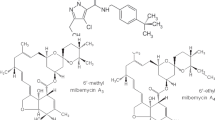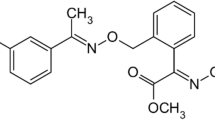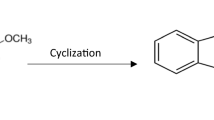Abstract
Etoxazole is a systemic acaricide widely used in several crops with important significance in strawberries in order to control mites. Consequently, the presence of etoxazole residues in strawberries cannot be excluded. But, are these residues safe for the consumers and in compliance with the regulatory limits? To address these questions, the dissipation kinetics and the terminal residue of etoxazole in field strawberry fruits in Egypt were investigated and a dietary exposure risk assessment was performed. A decline of etoxazole residues in strawberries as a first-order decay process demonstrating a half-life (t1/2) of 2.8 days and a significant degradation (97.7%) after 14 days. In all cases, variability factors estimated for etoxazole in strawberries were stable ranging from 1.50 to 1.94 at several preharvest intervals. Regarding the compliance with EUMRLs, the selection of the appropriate preharvest interval was critical. No evident risk to consumers was identified from the consumption of outdoor strawberries following the Good Agricultural Practices in Egypt.

Similar content being viewed by others
References
Afrin S, Gasparrini M et al (2016) Promising health benefits of the strawberry: a focus on clinical studies. J Agric Food Chem 64:4435–4449
Aguilera A, Valverde A et al (2012) Effect of household processing and unit to unit variability of azoxystrobin, acrinathrin and kresoxim methyl residues in zucchini. Food Control 25:594–600
Amatori S, Mazzoni L et al (2016) Polyphenol-rich strawberry extract (PRSE) shows in vitro and in vivo biological activity against invasive breast cancer cells. Sci Rep 6:30917
Bajwa U, Sandhu KS (2011) Effect of handling and processing on pesticide residues in food-are view. J Food Sci Technol 5:734–742
Boriss H, Brunke H, Kreith M (2006) Commodity profile: strawberries. Agricultural Issues Center. http://aic.ucdavis.edu/profiles/Strawberries-2006.pdf. Accessed 22 Mar 2015
Boulaid M, Aguilera A et al (2005) Effect of household processing and unit-to-unit variability of pyrifenox, pyridaben, and tralomethrin residues in tomatoes. J Agric Food Chem 53:4054–4058
Dekeyser MA (2005) Acaricide mode of action. Pest Manag Sci 61:103–110
EFSA (2005) Opinion of the scientific panel on plant health, plant protection products and their residues on a request from commission related to the appropriate variability factor(s) to be used for acute dietary exposure assessment of pesticide residues in fruit and vegetables. EFSA J 177:1–161
EFSA (2012) Reasoned opinion on the review of the existing maximum residue levels (MRLs) for etoxazole according to article 12 of regulation (EC) No 396/2005. EFSA J 10:2942
EFSA (2017) Peer review of the pesticide risk assessment of the active substance etoxazole. EFSA J 15:4988
Elgawad A (2019) Plant-parasitic nematodes of strawberry in Egypt: a review. Bull Nat Res Centre 43:7
EU (2016) COMMISSION REGULATION (EU) 2016/1016: amending Annexes II and III to Regulation (EC) No 396/2005 of the European Parliament and of the Council as regards maximum residue levels for ethofumesate, etoxazole, fenamidone, fluoxastrobin and flurtamone in or on certain products. In: E. Union (Ed.), 2016/1016. Official Journal of the European Union, 29.6.2016, L172/22
Fantke P, Juraske R (2013) Variability of pesticide dissipation half-lives in plants. Environ Sci Technol 47:3548–3562
Fantke P, Wieland P et al (2012) Parameterization models for pesticide exposure via crop consumption. Environ Sci Technol 46:12864–12872
Fantke P, Arnot JA, Doucette WJ (2016) Improving plant bioaccumulation science through consistent reporting of experimental data. J Environ Manag 181:374–384
FAO (2004) General guidliness for sampling (CAC/GL 50-2004) http://www.fao.org/uploads/media/Codex_2004_sampling_CAC_GL_50.pdf. Accessed 2 Sep 2019
FAO (Food and Agriculture Organisation of the United Nations) (2010) Etoxazole. In: Pesticide residues in food—2010. Report of the Joint Meeting of the FAO Panel of Experts on Pesticide Residues in Food and the Environment and the WHO Expert Group on Pesticide Residues. FAO Plant Production and Protection Paper 200, pp 209–226
FAO-Manual (2016) Submission and evaluation of pesticide residues data for the estimation of maximum residue levels in food and feed, 3rd edn. FAO, Washington (ISBN: 978-92-5-109133-3)
FAOSTAT (2020) Food and Agriculture Organization of the United Nations. http://www.fao.org/faostat/en/#search/Strawberries. Accessed 10 May 2019
Fernandez-Cruz ML, Villarroya M et al (2004) Field-incurred fenitrothion residues in kakis: comparison of individual fruits, composite samples, and peeled and cooked fruits. J Agric Food Chem 52:860–863
Forbes-Hernandez TY, Gasparrini M et al (2016) The healthy effects of strawberry polyphenols: which strategy behind antioxidant capacity? Crit Rev Food Sci 56:S46–S59
Hengel MJ (2011) Expanded method development for the determination of pesticides in dried hops by liquid chromatography with tandem mass spectrometry. J Am Soc Brew Chem 69:121–126
Jacobsen RE, Fantke P, Trapp S (2015) Analysing half-lives for pesticide dissipation in plants. SAR QSAR Environ Res 26:325–342
Jang J, Rahman MM, Abd El-Aty AM et al (2014) Analysis of etoxazole in red pepper after major modification of QuEChERS for gas chromatography-nitrogen phosphorus detection. Biomed Chromatogr 28:767–773
Lentza-Rizos C, Balokas A (2001) Residue levels of chlorpropham in individual tubers and composite samples of postharvest-treated potatoes. J Agric Food Chem 49:710–714
Lentza-Rizos C, Tsioumplekou M (2001) Residues of aldicarb in oranges: a unit-to-unit variability study. Food Addit Contam 18:886–897
Li Y, Yang N et al (2014) Evaluation of etoxazole against insects and acari in vegetables in China. J Insect Sci 14:104
Malhat F, Hassan A (2011) Level and fate of etoxazole in green bean (Phaseolus vulgaris). Bull Environ Contam Toxicol 87:190–193
Malhat F, Badawy H et al (2013) Determination of etoxazole residues in fruits and vegetables by SPE clean-up and HPLC-DAD. J Environ Sci Health B 48:331–335
Malhat F, Badawy HMA et al (2014) Residues, dissipation and safety evaluation of chromafenozide in strawberry under open field conditions. Food Chem 152:18–22
Nakajima T, Tsuruoka Y et al (2015) Determination and surveillance of nine acaricides and one metabolite in honey by liquid chromatography-tandem mass spectrometry. Food Addit Contam A 32:1099–1104
Pesticide Action Network (1998) Pesticide residues in food, Pest Managment Notes No 8. Pesticide Action Network UK
Rencuzogullari E, Ila HB et al (2004) The genotoxic effect of the new acaricide etoxazole. Russ J Genet 40:1300–1304
Saber AN, Malhat FM et al (2016) Dissipation dynamic, residue distribution and processing factor of hexythiazox in strawberry fruits under open field condition. Food Chem 196:1108–1116
SANTE/11945/2015 (2015) Guidance document on analytical quality control and method validation procedures for pesticides residues analysis in food and feed. European Commission Directorate-General for Health and Food Safety
Sawe BE (2017) Countries that produce the most strawberries. WorldAtlas. http://worldatlas.com/articles/which-countries-are-the-leading-producers-of-strawberries-in-the-world.html. Accessed 1 Sep 2019
Shibuya I (1999) Baroque (Etoxazole) new selective acaricide. Agrochem Jpn 74:18–19
Shin Y, Ryu JA et al (2008) Harvest maturity, storage temperature and relative humidity affect fruit quality, antioxidant contents and activity, and inhibition of cell proliferation of strawberry fruit. Postharvest Biol Technol 49:201–209
Trapp S, Legind CN (2011) Uptake of organic contaminants from soil into vegetables and fruits. In: Swartjes F (ed) Dealing with contaminated sites. Springer, Dordrecht, pp 369–408. https://doi.org/10.1007/978-90-481-9757-6_9
Wang M-C, Wu H-M et al (2009) Residue decline dynamics of etoxazole in orange and soil by UPLC-MS/MS. Chin J Pest Sci 04
Wang Z, Cang T et al (2018) Screening for suitable chemical acaricides against two-spotted spider mites, Tetranychus urticae, on greenhouse strawberries in China. Ecotoxicol Environ Saf 163:63–68
WHO (1997) Food consumption and exposure assessment of chemicals. World Health Organization, Geneva
WHO/GEMS (2012) WHO/Global environment monitoring system-food contamination monitoring and assessment program. Consumption cluster diets. Egypt. https://www.who.int/nutrition/landscape_analysis/nlis_gem_food/en/. Accessed 9 Jan 2019
Acknowledgements
The authors thank all members and staff of Pesticide Residues and Environmental Pollution Department, Central Agricultural Pesticides Laboratory, Agriculture Research Centre, Egypt, for their technical assistance.
Author information
Authors and Affiliations
Corresponding authors
Ethics declarations
Conflict of interest
All authors declare no conflict of interest.
Additional information
Publisher's Note
Springer Nature remains neutral with regard to jurisdictional claims in published maps and institutional affiliations.
Rights and permissions
About this article
Cite this article
Saber, A.N., Malhat, F., Anagnostopoulos, C. et al. Evaluation of dissipation, unit–unit-variability and terminal residue of etoxazole residues in strawberries from two different parts in Egypt. J Consum Prot Food Saf 15, 229–236 (2020). https://doi.org/10.1007/s00003-019-01266-w
Received:
Revised:
Accepted:
Published:
Issue Date:
DOI: https://doi.org/10.1007/s00003-019-01266-w




